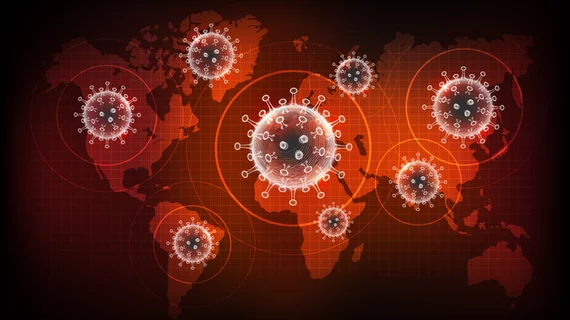Protecting patients and staff from exposure to the coronavirus should be a top priority for all radiology departments. And imaging experts from one such unit in China recently detailed their methodology and experience in a March 24 study.
Zixing Huang, with West China Hospital in the Sichuan province, kick-started their emergency management procedure on Jan. 21, describing the process, implementation, and results in the Journal of the American College of Radiology. They highlighted the reconfiguration of their rad unit, personal protection measures, staff training, and standardized exam procedures.
Although their 4,300-bed hospital was not at the center of the outbreak, Huang and colleagues’ planning protected everyone involved while maintaining departmental efficiency.
“We believe that our experience in management, the reconfiguration of our radiology department and the workflow changes implemented in the current COVID-19 situation are useful for other radiology departments that must prepare for dealing with patients with COVID-19,” they wrote, also noting that none of their personnel tested positive for the new virus nor developed symptoms, but indicated asymptomatic carriers were a possibility.
One of the first steps, Huang and colleagues wrote, is to realize that when dealing with infectious diseases such as the coronavirus, the highest level measures must be put into place. Below are key takeaways from their experience.
1. Have a radiology emergency management team
The institution’s radiology emergency management and infection control team (EMICT) was led by the department’s director, who oversaw the entire plan. Huang et al. noted that once the disease was identified, this team considered four things: gathering data, collaboration, assessing needs and expert advice.
For example, staff with direct patient contact received up-to-date case definitions and information about lab-confirmed positive cases to allow for proper precautions. Additionally, radiologists should know the typical and atypical imaging features of the disease. Huang et al. said their department stored all probable cases of COVID-19 in its PACS for easy viewing.
The EMICT was also responsible for dividing the imaging unit into four areas: contaminated, semi-contaminated, buffer and clean regions. Buffer zones included medical personnel access and dressing areas. Signs were also installed to help guide staff and patients through the confusion.
2. Protect and continually train staff
The hospital supplied personal protective equipment, including N95 masks, gloves clothing, etc., to all healthcare staff. It also built three “fever tents” for screening potential cases in the emergency department parking lot.
As part of the ongoing updates, the EMICT released the most up-to-date national and hospital-based information to staff via the communication app WeChat. It’s the most widely used social media app in China, the authors noted, and is an “indispensable tool for radiologists.”
Burnout is also a very real problem for staff working in contaminated areas under immense pressure. Time off can reduce both physical and mental stress. At West China Hospital, technologists on fever-CT shifts were given a break once a week for four hours.
3. Establish separate and detailed computed tomography protocols
The hospital established separate CT exam procedures for those with a fever and patients not suspected of having the new virus.
Huang and colleagues described the specific criteria for utilizing each process in the study and detailed each step of the exam, including the physical movement from the “fever tent” to the imaging room.
The radiologists also laid out their five-step equipment and environmental disinfection process in great detail.
Chest CT by itself was not used to diagnose the coronavirus, but still took on an important role for the hospital.
“In our opinion, the major role of chest CT is to understand the extent and dynamic evolution of lung lesions induced by COVID-19,” the authors wrote.
The JACR research was printed as a pre-proof study to provide early access to healthcare professionals. The full version will undergo additional technical changes.

